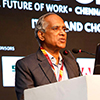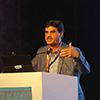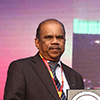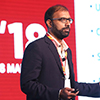ICT Academy started operating in Tamil Nadu in the year 2009. The objective of ICT Academy is to bridge the gap between industry and academia. In this pursuit, there are three key stakeholders, industry, academia and government; ICT Academy pursues leveraging all the three elements to ensure that the industry-academia gap is bridged. Having convened 31 editions of Bridge conferences, ICT Academy continues to embark on the journey with intent that is not just confined with India’s development, but with a vision of producing futuristic workforce for the entire world. With all vim and vigor ICT Academy will continue to impact the skilling space positively with the continued support from all its stakeholders and its 140 member team.
POWER PANEL

Lakshmi Narayanan
Chairman, ICT Academy,
Emeritus Vice Chairman,
Cognizant Technology Solutions
The theme "Future of Work" invokes questions about the types of jobs that will grow in the future, what are the types of jobs that will not grow, but probably get eliminated; these questions have no clear answers as of now. The World Economic Forum carried out a study in partnership with countries like UK and US and emerged with the findings that only 10% of the jobs that people perform today will grow in the future, about 15-20% of the jobs that are performed today will start declining, and the remaining 70-75% of the jobs are beyond the guess of the prospects. Hence, we are now in a complex situation to decide on investing for future. But there is only clear mention in the report about the pace of change, which will be rapid in the coming years unlike in the present. Clearly, the changes will be in the span of months and the readiness to confront it is extremely important.
However, the report has also predicted growth in two particular areas, namely the services domain and the education sector. The demand for teachers is to increase exponentially over the next several years. These predictions are proposed not only by The World Economic Forum, but several other reports that come from the UK. So much so, the investment in educational institutions and teaching is being stepped up, which is happening in India and every other part of the globe. Further, all these efforts made are focused on facilitating learning, improving learnability and increasing the level of learning that happens by teachers, by education institutions, by students, by practitioners, by workers across the globe. No longer will there be the time luxury of getting into a training room, being taught and getting ready to face the industry. People that graduate should literally learn newer things almost on a daily basis in order to stay relevant in an evolving industry scenario. This is a challenge, not just for the educational institutions, but also a huge challenge for the industry to partner with academic institutions in order to create that skill.

Dr. B Chandramohan ias
Secretary to Government, IT Department,
Government of Tamil Nadu
We are today faced with the prospects of an exponential technological revolution. The pace at which technology is changing is tremendous by the day that we cannot foresee what is likely to happen in the next few years. It is appropriate to say that the pace with which technology has changed our lives in the past 25 years is something that has never happened in the entire evolution of mankind, since the beginning. In the next 20 years, we will be facing technology at a scale that was hitherto unknown, or unforeseen. This conference is happening to give an understanding of such rapid paced change, to understand how we can prepare for that change. Henceforth, if we do not drive the technological change, it is quite possible that we may lose relevance to the society and the industry in due course of time. Many industries have seized to exist in the business that have foreseen the technology disruption and have not evolved in the pace of the revolution. Mahatma Gandhi has said that the future is what we prepare for in the present, and it is imperative today that we prepare for now to face the future. When the IT revolution began, the Government of Tamil Nadu took various measures to enable the IT revolution to take a foothold and develop in the state of Tamil Nadu. Starting from the IT policy, IT SEZs with partnership with industry, apart from which, the Government even went on to create joint ventures with the IT industry. Collaboration with the industry was forged to promote their activities by establishing specialized IT infrastructures to enable IT majors to come to Tamil Nadu.
In Tamil Nadu, the total value of software exports per annum is about 1 Lakh Crores. In spite of it, the Government realized that IT was limited to metropolitan cities. It was catering to a hugely western audience. In the second phase of the IT revolution, when tier-II cities had also started becoming IT hubs, ELCOT pioneered this move by starting SEZs in most of the tier-II cities, for which there was a considerable response. In fact, the cost of setting up and managing these kind of IT SEZs is far lesser in tier-2 cities. Hence, from a very metropolitan focused paradigm, ELCOT has moved to the tier-II, apart from being a pioneer in creating rural BPO in the country. Technologies like AI, IoT, Big Data Analytics etc., are moving from concepts to products and are replacing lot of jobs and roles already. Technology is to enhance the efficiency, accuracy and productivity and flexibility in large operations through automation. Hence, it is imperative that we understand the kind of disruption happening around us and get ourselves and the future generations prepared and equipped to grow midst the technology disruption.

Prof Bhaskar Ramamurthi
Director,
Indian Institute of Technology, Madras
Though it is a fact that we are grappling with this issue of fast changing environment, it is good not to inculcate fear midst people of the next generation. To eradicate fear from the students is to move away from the conventional heavy syllabus learning programs that have a typical sequencing which is worn out today. Instead, there should be more opportunities for them to learn through internships that happen with the understanding the seriousness of such learning exercises. Moreover, newer technologies and concepts should be introduced right away to teachers and students, as and when it is adopted by the industry. IIT has also developed an extensive program called NPTEL (National Program on Technology Enhanced Learning) by which it connects with so many colleges every semester, reaching millions of students, training and certifying them. Apart from these initiatives, it is important to stimulate students towards self-learning and encourage experiential learning, as these would inculcate a trait of adapting to change in the students, which will eventually help them staying industry-relevant throughout a career.
Whatever is the technological change, there are certain aspects that require human intelligence, and these iterations on self-learning, experiential learning, adapting to change are done in view of enabling the students to emerge to such stage that they play such roles in future.

Krishnakumar Natarajan
Executive Chairman, Mindtree
While Future of Work is being debated, many times there is a little negative connotation, which points to the huge numbers of graduates recruited into the Indian IT industry and questions at the possible decline in such numbers owing to a changing industry. But the fact is the world is changing; the ICT industry is no more what it was in the past. For example, the paper-based advertising industry is becoming a part of the ICT industry with the digitization happening in the field. Likewise, hospitality industry for the instance is falling into the ICT domain with more and more apps are coming to play part. Hence, ICT industry is no more a standalone industry; it is a much bigger and larger industry, which encompasses other industries gleaming with lot more optimism and opportunities in the future.
Further, the pace of adoption of technology is diminishing rapidly, and its impact on productivity is dramatically increasing. Hence the productivity in future in any domain will be manifold due to the technology disruption.
When many times Future of Work is discussed, only technologies like AI, Machine Learning, Augmented Reality, Virtual Reality are given a thought; but the fact is that to think of future of work is to think including the future workforce. The future workforce is very different; the millennial are multi-tasking workforce, whose idea of a career is different from that of the past generations. The future workforce has no concept of a lifetime employment, whereas many of them will opt to work in areas which they like and then move on with their other interests. The future workforce are driven more by self-learning, in accordance with which teaching methods should also change to augment self-learning through technology. Teaching should move to assisted teaching or mentorship, which is what the future workforce needs.
Hence, academia should not confine its thought with how the work will change, but should also think of what the future workforce will expect from teachers in terms of teacher-assisted learning and mentorship. This time of the era and the days to come will be more demanding of experiential learning, and educating the future workforce should be revamped according to such demanding scenario. While technology and automation are to eliminate the mundane tasks and jobs of today, there are going to be more jobs created that demand newer competencies. So, it is important for institutions like ICT Academy to understand what are the new jobs that are to be created, what are the competencies required for that and work with the industry and the Government to create those new skills ahead of time.
In totality, roles as teachers will change, the expectation of the future workforce will change, and we should be cognizant of the change and change ourselves.

Dr N Saravana Kumar
IAS, Joint Secretary, MHRD,
Government of India
Future of Work is going to be interplay between three important factors like the cutting-edge technologies, globalization and the demographic dividend. A recent study states that in a span of 5 years the job landscape is going to change in such a way that the existing jobs are going to remain at an approximate of 54% and 37% of the jobs would certainly require skill upgrade in order that the employees do not lose their jobs; a further 9% of the jobs will be completely new for which the skills required are not figured out now.
It has always been a difficult task to find a balance between focusing on excellence and equal access; for instance, it is like deciding between creating more institutes of excellence and providing education to all. Today, technology has brought a good balance between these two aspects. Similarly, employability in the higher education sector is a major challenge that the nation faces now. On the other hand improving the overall GER which is currently at 25% but varies state-wise, this is also a challenge to confront as the nation has set itself a target of pushing GER from 25-30% before 2020. This target will create an immediate demand of establishing 15000 institutions, which is highly impossible. Hence, the existence of brick and mortar model, and the model of learning through digital technologies are required. Given all these facts do not necessarily mean that technology will replace the teachers, because teaching involves human element, the face to face interaction, the thought process, empathy, communication and emotional intelligence to educate which are such attributes that are certainly human and there exists no alternative in any form. But, teachers are in such necessity to update themselves with emergent technologies.
In this connection, the MHRD is also taking some initiatives to arrive at a balance between excellence and equal access; SWAYAM is an initiative of the MHRD, which is India’s own MOOC (Massive Open Online Courses) model. These courses are not simple online content, but are built as an interactive architecture, which has a course coordinator, a discussion forum etc. The Ministry has also instructed UGC and AICTE to allow up to 20% of the courses to be done through SWAYAM portal. In response to the complex situation of necessity to increase the Gross Enrolment Ratio in spite of the shrinking space availability to create more brick and mortar institutions. Hence, enhancing access to education, and improving the higher education system and to improve its global rankings, digital learning modes should essentially be adopted.
Moreover, MHRD is engaged in such initiatives like IMPRINT and Uchchattar Avishkar Yojana that include industry and research. Initiatives like these focus on serious research in socially relevant fields and the areas which are being thrown up by the industry. The third one is the announcement of Prime Minister’s Research Fellowship in the recent budget, under which, 1000 B.Tech students will be allowed to do 5 year direct PhD with full scholarship. This is basically to improve the research interest and to increase the number of patents India has, as currently, India has only 40 patents per one million population whereas, South Korea has 2000+ and China has 400 patents.
All these initiatives beat around the question of man Vs machine. It would be apt to quote the words of Martin Luther King to answer this question, who said “we have more guided missiles but unguided people”. Similarly, we have more upgraded and trained machines, but people with less values and morals. So, to answer the question of handling the technology invasion, it is impossible to hold the technology, hence, we should think of what to do with the human element. In the words of Peter Drucker, the Modern Management Guru “we are not here to breed a race of super humans” in the light of which it should be understood that such skills should be imparted that the products from, higher educational institutions are capable of managing the supercomputing machines. That is the key element which the industry and academia should keenly focus. Higher education system must concentrate on producing employable resources, as the focus is on Education 4.0 to re-align with the industry 4.0. Education 4.0 is not like the earlier models of just receiving the knowledge. It will comprise such teaching methods that are aligned with the students’ needs and the industry needs.
In this new era and in the future the concept of “learn, work and retire” is out of context; only learning, working and relearning will be the order. Hence, students should be nourished with a drive for life-long learning.

Dr. M P Poonia
Vice Chairman,
All India Council for Technical Education (AICTE)
As far as AICTE is concerned, the infrastructure created for higher technical education in this country is capable of accommodating 3.7 million students every year, which is a number greater than the total population of Singapore. But we are able to attract only 2 million students towards technical education and 1.7 million of the students are not getting enrolled, which is a painful fact that the infrastructures established for the purpose remain hugely unutilized. Further, out of the 2 million students joining technical education courses only 1.3 million actually graduate; many of them either dropout due to lack of interest, or due to high course fees. Eventually, only 7 million of the 1.3 million graduating get actually employed. This is because there is a difference between the requirement of the society and what students are being taught.
AICTE, in line with these scenarios has taken curriculum revamping initiatives involving all IITs, all NITs and industry leaders together and has come up with a model curriculum, which is available in the AICTE official web portal. But, the question now is how teachers will disseminate this new curriculum without them changing primarily. The society has a great respect to teachers and the teaching community; hence, it becomes the responsibility of the teachers to live up to the society’s faith in them.
Further, AICTE is introducing a mandatory internship policy, which demands every student to work for a period of 6 months in the industry and learn everything about what the industry does. AICTE has in pipelinea mandatory training initiative for teachers, which will have 8 modules of courses available on SWAYAM platform that can be downloaded, learnt and disseminated to students.

Padma Bhushan Dr A Sivathanu Pillai
Honorary Distinguished Professor,
ISRO and Founder, Brahmos Aerospace
The future is to have sustainable development. Science came out of discoveries, inventions and innovations and technologies add value, with knowledge solution the value increases; these are the means through which we reach the competitive space; and that’s how comes the sustainable development. Technological innovations can affect the most fundamental changes in the ground rules of economic competitiveness and the environment, resulting in sustainable development in the society. But the whole thing is happening at a faster pace now, which we are grappling today to cope. The major point is that the world is changing to knowledge age; knowledge and technology are the very important aspects for the future. This knowledge age can be really capitalized by us, as we have got 600 million youth. If we can impart skillsets with equity of access and overcome the challenges, the world will be ours. Moreover, technology is the pivotal tool in accelerating change. Technology, particularly will play important roles in R&D, which draws an annual spend of more than 3500 crore every year exclusively. Then is the role of academia; if the infrastructure of academia is converted into high technology research stations, and world-class laboratories, then brain drain could be reversed. Industry is the third partner which must work with the academia in order to produce globally competitive products that will bring wealth through export. If the roles of these players are synergized, then we will definitely become a global leader.

Ram Singampalli
Chief Delivery Officer,
Syntel Inc
A century old quote of Albert Einstein on automation, states that “the vision of ultimate automation is possible with intelligence that is beyond human intelligence or super intelligence”. This super intelligence could be evolved through the integration of the computing power, devices, connectivity and AI (Artificial Intelligence). The human brain involves about 30000 trillion transactions or instructions per second, and if the current technology is evolved in the right path, creating a device that is equivalent to human brain is possible, which will increase the computing power. If such device is evolved further, in another 30-40 years, devices that are equivalent to the brain capacities of humans will be possible. Moreover, the cost of devices and connectivity or competitively decreasing, which will eventually enhance the computing power and fuel the bloom of super intelligence. Hence, it is evident that Super Intelligence is here, it is closer and it is fuelled by these 4 drivers of technology.
Further, positive and negative predictions of change have always been in the talk through the ages. Such talks create uncertainty about future generally. But, when confronted with uncertainty, preparing with a strong foundation that would help sailing through the uncertain times is essential. Today, the exercise of strengthening the foundation should be in sync with the pace of change in the industry. In early ages, the industry was such that core learning happened only till employment. But in the era of Industry Revolution 4.0 it is no more “learn once and perform for a lifetime”; it is “learn everyday and perform everyday”. If this is the fundamental shift, then it is essential to think about making the future workforce to learn. The solution is teaching the future workforce how to learn will only motivate them to emerge as lifelong learners. The future workforce should be trained to develop the attribute of cognitive flexibility, which means dealing with ambiguity and uncertainty. Moreover, in the future of work appreciation for multi-disciplinary knowledge is very important. Another key skill essential for future workforce is visualization as there is greater room for design thinking. These are the three attributes required for future workforce to thrive in a rapidly changing industry scenario.

Debapriya Nandan
Sr. Director, Oracle India
The future of work is evolving now. Who better than the public sector can push it forward? In the past, when the Railways developed the ICF Coach in India, the technology was not available; we started manufacturing equipments and circuits in India. Moreover, the Railways trained huge numbers of local entrepreneurs to manufacture the parts required in India. Even in the Northeast part of India there were hundreds of industries started manufacturing those parts and ICF got a 100% indigenized coach. On the education front, this kind of creation of internal requirement opened avenues where courses on welding, mechanical stuff and so many other things emerged. The point is, organizations as huge as Railways that have the wherewithal, the money, the wish and the push and the influence within the Government to create that kind of ecosystem should work on such initiatives.
On the other hand growth in every sector is happening at an accelerated pace today, and has already raised the question of sustainability. The question of sustainability could be answered only when we have manpower that is available in abundance, not that costly. This responsibility possibly of spawning out huge numbers of talents that is skilled in their respective domains lies in the hands of the academia. This is such juncture at which, ICT Academy is doing a wonderful job of mitigating the industry-academia divide to enable academia produce more skilled talents.
Further, large PSUs should invest in Research, Robotics, Artificial Intelligence, Data Analytics, IoT and Quantum Communication to take it to the institutions of every kind and every size that are situated in tier II and III cities, villages and to incubate entrepreneurs to get them with such skills and capabilities to take part in the industry midst an evolving industry scenario. Moreover, the Industry Revolution 4.0 is to bring out such products that are highly innovative. Hence, even the last-mile worker should possess such skills to deal with the futuristic products, services, and other evolved business models.

Pundi Sriram
Co-Founder and Head,
STEP – The Hindu Group
We know the world is changing; but how is it going to change with respect to skills is the question. The World Economic Forum has identified various skills that the workforce of 2020 will require that ranges from complex problem solving, critical thinking, creativity, people management, coordinating etc. The interesting aspect of this list is that it does not enlist any of the technology skills that are discussed and debated today. Instead, the skills enlisted by the World Economic Forum in report on Future of Jobs indicate that skills and abilities are two different fortes; skills are acquirable with some training and practices, but that are modifiable, whereas abilities on the other hand are much harder to build, they are stable and enduring, and abilities form the bases upon which the skills are built. It should be realized that companies hire people for their skills but fire them for their less abilities. Particularly, cognitive abilities are important in today’s context as these are the abilities that enable individuals to have a drive for learning.
Further, one of the keys to develop cognitive abilities is language skills; because without language skills it is very difficult to acquire problem solving skills. English language learning skills are critical in the today’s environment to be able to build the kind of skills that are debated about in regard with relevance of talents in the future of work. But to equip the students just give them access to information and they will surprise us in terms of their progress in learning, as students can learn at the highest possible levels, they can demonstrate abilities at highest possible levels. Majorly, the problem of lack of proficiency in language learning or developing cognitive abilities still persists when students go for work. The expectations of the jobs are such that individuals are required to analyse and summarise data, they will be expected to be able to explain what they are doing in a story form, debate to justify their position. Every action they do in the job will require actions like discussing, debating, solving etc.
Finally, a study presents a fact that Indians, on an average consider themselves to be not knowledgeable inEnglish is familiar with about 3000 words in English. Hence, there is plenty of latent English in everybody; being able to figure out that and help them use it is what is important. This could be done by assessing their basic language proficiency and benchmark them accordingly in order that the learners come to know their goal in the path of learning, and recruiters shall rope-in people based on the candidate’s defined proficiency.